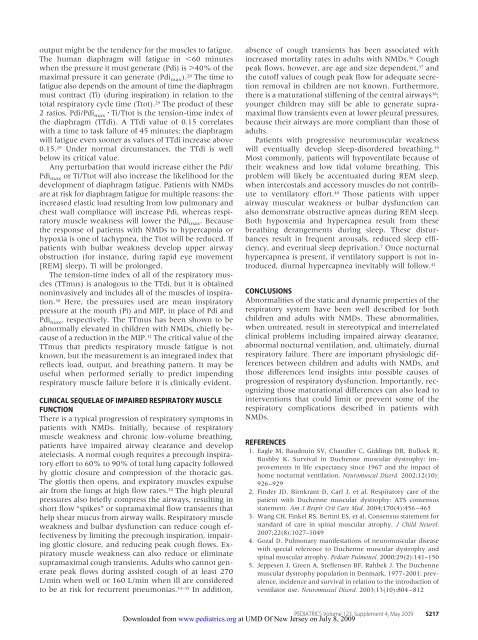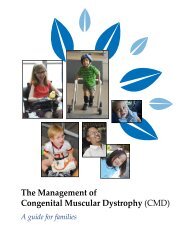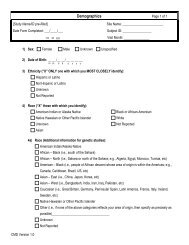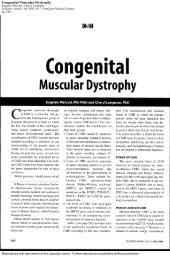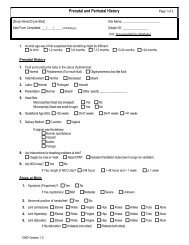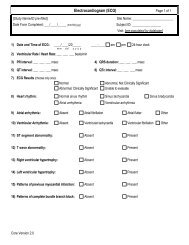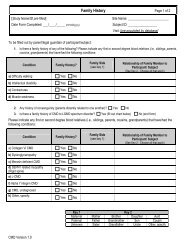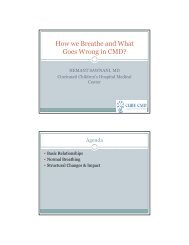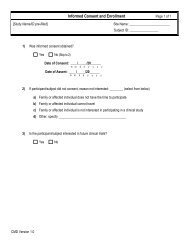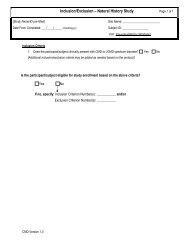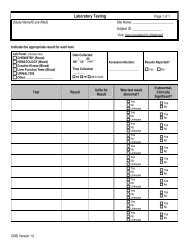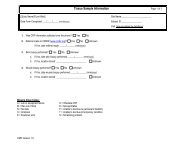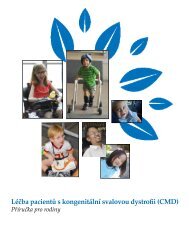Pathophysiology of Respiratory Impairment - Cure CMD
Pathophysiology of Respiratory Impairment - Cure CMD
Pathophysiology of Respiratory Impairment - Cure CMD
- No tags were found...
Create successful ePaper yourself
Turn your PDF publications into a flip-book with our unique Google optimized e-Paper software.
output might be the tendency for the muscles to fatigue.The human diaphragm will fatigue in 60 minuteswhen the pressure it must generate (Pdi) is 40% <strong>of</strong> themaximal pressure it can generate (Pdi max ). 28 The time t<strong>of</strong>atigue also depends on the amount <strong>of</strong> time the diaphragmmust contract (Ti) (during inspiration) in relation to thetotal respiratory cycle time (Ttot). 29 The product <strong>of</strong> these2 ratios, Pdi/Pdi max Ti/Ttot is the tension-time index <strong>of</strong>the diaphragm (TTdi). A TTdi value <strong>of</strong> 0.15 correlateswith a time to task failure <strong>of</strong> 45 minutes; the diaphragmwill fatigue even sooner as values <strong>of</strong> TTdi increase above0.15. 29 Under normal circumstances, the TTdi is wellbelow its critical value.Any perturbation that would increase either the Pdi/Pdi max or Ti/Ttot will also increase the likelihood for thedevelopment <strong>of</strong> diaphragm fatigue. Patients with NMDsare at risk for diaphragm fatigue for multiple reasons: theincreased elastic load resulting from low pulmonary andchest wall compliance will increase Pdi, whereas respiratorymuscle weakness will lower the Pdi max . Becausethe response <strong>of</strong> patients with NMDs to hypercapnia orhypoxia is one <strong>of</strong> tachypnea, the Ttot will be reduced. Ifpatients with bulbar weakness develop upper airwayobstruction (for instance, during rapid eye movement[REM] sleep), Ti will be prolonged.The tension-time index <strong>of</strong> all <strong>of</strong> the respiratory muscles(TTmus) is analogous to the TTdi, but it is obtainednoninvasively and includes all <strong>of</strong> the muscles <strong>of</strong> inspiration.30 Here, the pressures used are mean inspiratorypressure at the mouth (Pi) and MIP, in place <strong>of</strong> Pdi andPdi max , respectively. The TTmus has been shown to beabnormally elevated in children with NMDs, chiefly because<strong>of</strong> a reduction in the MIP. 31 The critical value <strong>of</strong> theTTmus that predicts respiratory muscle fatigue is notknown, but the measurement is an integrated index thatreflects load, output, and breathing pattern. It may beuseful when performed serially to predict impendingrespiratory muscle failure before it is clinically evident.CLINICAL SEQUELAE OF IMPAIRED RESPIRATORY MUSCLEFUNCTIONThere is a typical progression <strong>of</strong> respiratory symptoms inpatients with NMDs. Initially, because <strong>of</strong> respiratorymuscle weakness and chronic low-volume breathing,patients have impaired airway clearance and developatelectasis. A normal cough requires a precough inspiratoryeffort to 60% to 90% <strong>of</strong> total lung capacity followedby glottic closure and compression <strong>of</strong> the thoracic gas.The glottis then opens, and expiratory muscles expulseair from the lungs at high flow rates. 32 The high pleuralpressures also briefly compress the airways, resulting inshort flow “spikes” or supramaximal flow transients thathelp shear mucus from airway walls. <strong>Respiratory</strong> muscleweakness and bulbar dysfunction can reduce cough effectivenessby limiting the precough inspiration, impairingglottic closure, and reducing peak cough flows. Expiratorymuscle weakness can also reduce or eliminatesupramaximal cough transients. Adults who cannot generatepeak flows during assisted cough <strong>of</strong> at least 270L/min when well or 160 L/min when ill are consideredto be at risk for recurrent pneumonias. 33–35 In addition,absence <strong>of</strong> cough transients has been associated withincreased mortality rates in adults with NMDs. 36 Coughpeak flows, however, are age and size dependent, 37 andthe cut<strong>of</strong>f values <strong>of</strong> cough peak flow for adequate secretionremoval in children are not known. Furthermore,there is a maturational stiffening <strong>of</strong> the central airways 38 ;younger children may still be able to generate supramaximalflow transients even at lower pleural pressures,because their airways are more compliant than those <strong>of</strong>adults.Patients with progressive neuromuscular weaknesswill eventually develop sleep-disordered breathing. 39Most commonly, patients will hypoventilate because <strong>of</strong>their weakness and low tidal volume breathing. Thisproblem will likely be accentuated during REM sleep,when intercostals and accessory muscles do not contributeto ventilatory effort. 40 Those patients with upperairway muscular weakness or bulbar dysfunction canalso demonstrate obstructive apneas during REM sleep.Both hypoxemia and hypercapnea result from thesebreathing derangements during sleep. These disturbancesresult in frequent arousals, reduced sleep efficiency,and eventual sleep deprivation. 7 Once nocturnalhypercapnea is present, if ventilatory support is not introduced,diurnal hypercapnea inevitably will follow. 41CONCLUSIONSAbnormalities <strong>of</strong> the static and dynamic properties <strong>of</strong> therespiratory system have been well described for bothchildren and adults with NMDs. These abnormalities,when untreated, result in stereotypical and interrelatedclinical problems including impaired airway clearance,abnormal nocturnal ventilation, and, ultimately, diurnalrespiratory failure. There are important physiologic differencesbetween children and adults with NMDs, andthose differences lend insights into possible causes <strong>of</strong>progression <strong>of</strong> respiratory dysfunction. Importantly, recognizingthose maturational differences can also lead tointerventions that could limit or prevent some <strong>of</strong> therespiratory complications described in patients withNMDs.REFERENCES1. Eagle M, Baudouin SV, Chandler C, Giddings DR, Bullock R,Bushby K. Survival in Duchenne muscular dystrophy: improvementsin life expectancy since 1967 and the impact <strong>of</strong>home nocturnal ventilation. Neuromuscul Disord. 2002;12(10):926–9292. Finder JD, Birnkrant D, Carl J, et al. <strong>Respiratory</strong> care <strong>of</strong> thepatient with Duchenne muscular dystrophy: ATS consensusstatement. Am J Respir Crit Care Med. 2004;170(4):456–4653. Wang CH, Finkel RS, Bertini ES, et al. Consensus statement forstandard <strong>of</strong> care in spinal muscular atrophy. J Child Neurol.2007;22(8):1027–10494. Gozal D. Pulmonary manifestations <strong>of</strong> neuromuscular diseasewith special reference to Duchenne muscular dystrophy andspinal muscular atrophy. Pediatr Pulmonol. 2000;29(2):141–1505. Jeppesen J, Green A, Steffensen BF, Rahbek J. The Duchennemuscular dystrophy population in Denmark, 1977–2001: prevalence,incidence and survival in relation to the introduction <strong>of</strong>ventilator use. Neuromuscul Disord. 2003;13(10):804–812PEDIATRICS Volume 123, Supplement 4, May 2009Downloaded from www.pediatrics.org at UMD Of New Jersey on July 8, 2009S217


